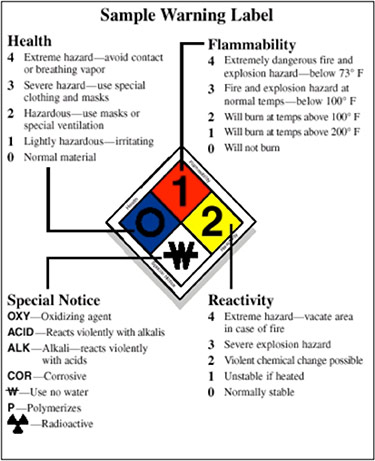Flammable Liquid Safety
Flammable liquids are used widely in many workplace and home situations and in many different ways. They present unique hazards to the people that use them. Flammable liquids can cause a fire or explosion and overexposure to them may also cause serious health effects. Here we’ll discuss how to safely use flammable liquids and avoid hazards.
Flammable liquids are liquids with a flash point of less than 100°F. The flash point is the lowest temperature at which a liquid gives off enough vapor to form a flammable mixture with air. On the National Fire Prevention Association (NFPA) diamond label, a fire hazard rating of 3 or 4 denotes a flammable liquid. Other labels used to identify flammable liquids are red with appropriate wording, and they usually contain a fire symbol.
The vapors of a flammable liquid often present the most serious hazard. The vapors can easily ignite or explode. Because these vapors are heavier than air, they may settle in low spots, or move a significant distance from the liquid itself.
The explosive concentration of vapors in air has a lower and upper limit. The lower explosive limit, or LEL, is the lowest concentration that will ignite. The upper explosive limit, or UEL, is the highest concentration that will ignite. If the vapor concentration is between the LEL and UEL, there is serious risk of fire or explosion.
Follow these Precautions to Minimize the Risk of Flammable Liquids:
-
Always check the SDS’s for the material you’re using to understand the specific hazards involved.
-
Store flammable liquids in cool, well-ventilated areas away from corrosives, oxidizers, and ignition sources.
-
Label all containers and cabinets with appropriate “flammable materials” signs.
-
Never smoke in an area where flammable liquids are used or stored.
-
Minimize the amount of flammable liquids used.
-
Use only approved safety cans to store flammable liquids.
-
Ground and bond flammable liquid containers to prevent static charge buildup.
-
Never pour flammable liquids down a drain or sink.
-
Dispose of empty flammable containers in an approved manner.
- Wear appropriate personal protective equipment, such as splash aprons and goggles, when handling flammable liquids.
Eye Contact with flammable liquids can cause burning, irritation, and eye damage.
Ingestion of flammable liquids can irritate the digestive tract, or even cause poisoning or death.
Appropriate personal protective equipment (PPE) can help prevent exposure to flammable liquids. Use PPE faithfully to protect your good health.
Careless mistakes and safety shortcuts lead to serious problems when it comes to flammable liquids. Their hazards are deadly. You can prevent problems from occurring by using your good sense, following today’s tips, and observing SDS’s precautions.
NFPA Diamond

Open the Door to Safety: Awareness is the Key!
Download flyer: SMOTW_30_Flammable Liquid Safety.pdf (202.46 kb)

